
1. Tver (Ar Denga) Ivan Mikhailovich (1399-1425)
Russian national coinage will celebrate its thousandth anniversary in 1988. The most ancient issues were struck between 988 and 1019, of which 11 gold and 330 silver pieces are known. All are modeled after Byzantine types, probably because of the then recent "conversion" of the country to Orthodox religion. These ancient coins circulated in Russia alongside Arabic dirhems and Western European coinage. In Russia, the twelfth through the early fourteenth centuries are known as the coinless period, when solid silver bars provided the principal medium of exchange. The minting of Russian coins resumed in the second half of the fourteenth century with the introduction of "wire money" - crude, irregular shapes of metal stamped with the mark of an issuing authority.
The ancient coins of Russia were struck on behalf of the princes of Kiev, the political and economic capital from the tenth to twelfth centuries. The small quantities found indicate that this early coinage was not meant for trade but rather was a self-proclaimed declaration of importance on behalf of the Kievan Princes. In 1169 Kiev was sacked by the Russian prince Andrei of Suzdal who then moved the capital to the northeastern city of Vladimir. The decline of Kiev was cemented by the Mongol invasion of the thirteenth century as the city was sacked in 1240. For the next two hundred years all of Russia was under the Mongol yoke. Devastating raids, humiliating tribute and slavery were common occurrences during this period. Under the suzerainty of the Mongol Khans, the city of Vladimir remained the nominal capital of Russia.
The Russian political system of this era consisted of a Grand Prince, originally the Prince of Kiev. A principality consisted of a major city and the lands and smaller cities surrounding and dependent upon that city. In essence, they were city-states. Under the Grand Prince were princes of other principalities in varying ranks based upon seniority. The title Grand Prince was used by several of these princes.
The basis for Grand Princely succession was not fixed. Sometimes it was based on the law of primogeniture, sometimes title passed to a brother, sometimes it was taken by force or bribe. After the Mongol conquest the Grand Prince had to be sanctioned by the Great Khan, who would bestow and revoke the title based upon promises of tribute. It was common for a given prince to win and then lose this title several times in his lifetime. The Grand Prince was the senior political leader of the Russian lands - assuming, of course, that the "junior" princes allowed him to rule them. By tradition, the Grand Prince was also considered the Prince of Vladimir even if his "home" was a different principality. The other Russian princes acknowledged the seniority of the grand princes of Vladimir and, although not always readily, lent their support to policies designed to achieve common objectives.
In the early fourteenth century Moscow surpassed Vladimir as the center of Grand Princely power under Ivan Kalita. This occurred through armed interference as well as outright purchases of nearby lands. Eventually the Russian lands would be unified around the Great Principality of Moscow. This article will trace the development of the coinage of Moscow during the unification phase of Russian history. This period, commencing about 1380, is a period of feudal disintegration and internecine war, characterized by the absence of any feeling of national unity. The period ends with the unification of Russia under Moscow during the reign of Ivan III (The Great), who ruled from 1503 to 1533. Ivan III finally developed the notion of tsar and was in fact the first Russian Grand Prince to use that title. The concept of tsar was to be fully realized in Ivan's son Vasili III and grandson Ivan IV (The Terrible). The title tsar is a corruption of the Latin Caesar. Before discussing the actual coinage, the historical scene of this chaotic period must be described.
After more than a three hundred year hiatus, Russian coinage resumed in the second half of the fourteenth century. At this time the Mongol yoke had been over Russia for more than 100 years yet internal strife and rivalries had weakened the Mongols' previously invincible strength. In 1380 the Russians, under Dimitri Donskoi, stunningly defeated the Mongols at the battle of Kulikovo, on the banks of the Don River. Dimitri's surname, literally "of the Don" originated from this victory. This was the first major setback for the Mongols and it gave the Russian people hope for future liberation. Concurrent with weakening Mongol rule, Russian trade and commodity manufacture revived and the population shifts due to the Mongol invasions slowed. Local economies were strengthened and a convenient medium of exchange was necessary. This led to the resumption of coinage. Propaganda also played a part as local princes proclaimed their somewhat autonomous positions coincident with the above economic changes. Numerous major and minor princes issued identifiable coins.
At the end of the fourteenth century four Great Principalities (including Moscow) dominated the Russian scene. Tver, Ryazan and Suzdal/Nizhny-Novgorod were all independent to a large degree, even though the Prince of Moscow held the Grand Princely title. The striking of coins then occurred almost simultaneously in Central and Eastern Russia, first in Moscow and then soon after in Suzdal/Nizhny-Novgorod and Ryazan. Tver coinage started shortly after 1400. In addition, many "junior" princes struck local private coinage in feudal domains dependent upon the above Great Principalities. (See map on previous page).
Previously the Prince of Tver was defeated in a struggle for Grand Princely rule by the Moscow Prince. As a result, the Tver principality became isolated from the outside world (Fig. 1-3). Tver coinage is known for its multitude of design types. Tver did maintain a rather tenuous independence from Moscow until 1486, when Ivan III annexed it.
At this point, Dimitri Donskoi (of the Don River), as Grand Prince, merged the throne of Vladimir into that of the Great Principality of Moscow. He achieved this through his glory at the battle of Kulikovo and his placating of the Mongol Khan. After Kulikovo, the Khan Mamai was overthrown and replaced by Khan Tokhtamish. In 1382, Tokhtamish led a new invasion of Russia to avenge the previous Mongol defeat. Moscow was sacked and, as a result, the Russian princes, under Dimitri, agreed to new submissions to the Mongols. Substantial tribute was promised and Dimitri was the sole collector on behalf of the Mongols. Thus, he curried favor from the Khan and assured his retention of the Grand Princely title. His testament would begin a hereditary right of succession of the throne. Future Grand Princes would be chosen from the Princes of Moscow. This was the start of the unification process.
The Great Principality of Ryazan played no part in the previously mentioned struggle between Tver and Moscow. Ryazan, situated southeast of Moscow, took the first and heaviest blows of the Mongol invasion. In 1237 the city of Ryazan was pillaged and burned. At that time the Grand Prince was not sufficiently strong to mobilize a force to try to protect the eastern frontier. Eventually the Mongol Horde would sweep across most of the Russian lands. Due to its geographic site, Ryazan would continue to be the target of frequent Mongol raids. As a result Ryazan culture and politics were heavily influenced by the Mongols. Even their later coinage would initially consist of counterstamped Mongol coins (Fig. 4). Ryazan was annexed to the Moscow territories in 1520.
The Great Principality of Suzdal/Nizhny-Novgorod was dominated by the two major cities Suzdal and Nizhny-Novgorod, both northeast of Moscow. Suzdal was quite ancient and had had a glorious past. By the end of the fourteenth century, however, Nizhny-Novgorod became the main center of the principality. Like Ryazan, Nizhny-Novgorod was an eastern frontier city, acting as a buffer between hostile neighbors and the central Muscovite lands. It remained a Great Principality, with independent princes, as long as the Moscow Princes were unable to fortify and colonize the eastern frontier. As Moscow grew, its independence declined until it was annexed in 1451. Like Ryazan, the early coinage of Suzdal/Nizhny-Novgorod shows definite Mongol influence, including Arabic legends (Fig. 5).
The northern city of Novgorod was quite important at this time, especially economically, as it was a center of trade with the West. Novgorod is not considered a principality but rather a democratic city-state where the ruling prince was no more than a figurehead. Real rule rested with the town council. Novgorod was taken by Moscow in 1478 (Fig. 6).
As stated above, coinage resumed first in Moscow, under the authority of Grand Prince Dimitri Donskoi. Several key factors contributed to the rise of Moscow. Its strategic location at the center of the intricate river system of Russia was important as was the fact that both the Grand Prince and the Metropolitan of the Russian Church were situated at Moscow. After the Mongol invasions many of the masses of people who left the ravaged eastern frontier passed through and settled in the Principality of Moscow. In 1389 Dimitri was succeeded by his son Vasili I who ruled until 1425. Next came Vasili II, the son of Vasili I, who was then succeeded by Ivan III in 1462. The coinage of these four rulers, all descendents of Ivan Kalita, encompasses the unification phase of Russia.
The extreme diversity of pictorial types represented by these coins attests to the lack of a central mint during this period. Evidently the striking of coins was contracted out, probably to a number of silversmiths, some of whom would strike coins for several princes concurrently. Thus, some design similarities do exist. Gold coins from this period are not known with the exception of a unique gold "ducat" of Ivan III dating from about 1484 (Fig. 7). Mostly anonymous copper coins were struck for local use in the reigns of Vasili II and Ivan III. The denomination of the copper coins, Pul or Pulo, is shown on the coins themselves - "Pulo Moscovskoye - Pulo of Moscow" (Fig. 8-9) but the relationship of copper to silver is not known and probably fluctuated depending upon time and place. The denomination of the silver coins, denga, is found only rarely on coins from this period. Subsequently the term dengi came to be the Russian word for the concept of money. The terms pulo and denga are probably of Mongol origin and are unknown to literary sources of the pre-Mongol era.
The term "wire money" is derived from the universal minting technique used for both silver and copper coins. The planchets were literally made from rolled silver or copper wire which was then cut into appropriate sections, depending upon the desired weight. The metal was annealed and then struck into coinage. In the fourteenth and fifteenth centuries the wire was generally not flattened before insertion into the dies. In the sixteenth and seventeenth centuries, as coin weights were reduced and planchets became smaller the wire was first flattened before striking. Thus the earlier issues are decidedly rare with complete legends and designs. Well struck specimens command a substantial premium. Irregular shapes are the rule for this series. Elsewhere in Europe minting techniques included hammering silver into sheets and then cutting planchets out of these sheets. This system was inefficient as the waste silver had to be remelted in order to be re-used. However, greater regularity of the coin blanks was obtained with the European system.
The earliest artistic representations on the coins exhibit substantial internal development when compared to Mongol coinage. After more than a hundred years of subjection to the Mongol Horde, it is surprising to see the richness of Russian coinage as opposed to mainly epigraphic coins of the east. Generally speaking, the images on coins of this period show no evolution or common thread. Random designs predominate. Yet this randomness points to an originality of design not as evident in other European countries. Types represented on the coins include human figures, scenes of the hunt and combat, horsemen, animals and decorative symbols. Obviously, combinations of these images are also known. Considering the coin sizes (usually 9 or 10 mm) the images were not as restricted as one would think. The entire medieval period is marked by this diversity of types except for cities of Novgorod and Pskov. This was probably due to a greater centralization of minting operations in those two cities. The licensing to metal artisans in the rest of Russian allowed for substantial latitude in design selection. Specific types of each ruler will be discussed in conjunction with the legends.
The inscriptions on the coins are either in Russian or are bilingual, Russian and Arabic. The bilingual issues were common during the Mongol domination. Most medieval Russian coins commonly specify the issuing prince's name and patronymic (his father's name e.g. "Dimitri Ivanovich - Dimitri, son of Ivan"). If both names are present on a coin attribution is simplified. The absence of the patronymic creates difficulty because of the common usage of identical names by princes of different principalities. Some coins of this period are anonymous or illegible and there are still many coins not positively attributed to a given city, let alone a specific prince. The coins of the principality of Suzdal/Nizhny-Novgorod especially are quite confusing.
The coin inscriptions initially read "Seal of the Grand Prince" and the prince's name. Then the word "seal" is dropped but the grammar still denotes possession "by the Grand Prince." As Moscow grew in importance and power, the title on the coins matured. First to "Grand Prince of all Russia" and then to "Sovereign of all the Russian lands." Ivan III was the first Russian ruler to call himself tsar but the title does not appear on his coins. His son, Vasili III (1505-33) was the first to use this title on coins. In the fifteenth century, a unique Latin inscription is found on coins of Ivan III. The inscription "Ornistotelis" (Fig. 1 1) probably refers to the moneyer for the issue. The name "Master Alexandro" (Fig. 10) appears in a Russian inscription on another coin of Ivan III. Once again this was the name of a moneyer.
The first coins of Moscow were probably struck as a result of Dimitri Donskoi's victory at Kulikovo. The battle thrust the Prince of Moscow into the political forefront of Russia and sparked a desire to proclaim this importance. Unfortunately the sacking of Moscow in 1382 by Tokhtamish restored Mongol rule but the Russian victory was not forgotten. All coins of Dimitri Donskoi carry an Arabic inscription on the reverse, usually with the name of the reigning Khan Tokhtamish signifying the continued subservience (Fig. 12-14). However, there is no direct indication in any source that attests this was done at the orders of the Khan. It is likely that after the raid of 1382, Dimitri wished to pay homage to the Khan to avoid further punitive expeditions against Russia. In spite of the victory of 1380, the Russian princes were not truly united, even against a common enemy. Further, between prior Mongol raids and the "Black Death" of the 1350s, the Russian population was exhausted. The obverse of Dimitri's coins consists of the circular legend "Seal of Grand Prince Dimitri", enclosing the figure of a rooster or a human male head. While no significance is attached to the pictorial design, the legend obviously declares his right to the Grand Princely throne. The fact that the Khan still had to sanction his rule did not dilute its meaning. All coins of Dimitri are rare.
Dimitri's son Vasili continued to strike coins, though on a much larger scale than his father. Both series are somewhat similar in appearance, but the metrology is different due to weight and purity reductions. The coin reverses continue the Arabic inscriptions of Dimitri including naming Khan Tokhtamish, due to Vasili's need for confirmation of his throne from that Khan. The Khan was overthrown by Timur (Tamerlane) in 1395 who hastened the Mongol decline and lessened their grip on Russia.
Vasili had inherited a difficult political situation. While the Mongol threat began to wane, encroachments from Lithuania began in spite of Vasili's marriage to the daughter of Vitovt, the Grand Prince of Lithuania. Vitovt had designs on the Moscow throne. Meanwhile the control of Moscow over Tver, Ryazan, and Novgorod was terribly weak, with these lands conducting their affairs independently. More positively, Vasili had continued to extend the Moscow domain by seizing the principality of Suzdal/Nizhny-Novgorod in 1392. His rule there did not last long, however, and it was not officially annexed until 1451 under Vasili 11.
In 1417 Vasili I's eldest son Ivan died and the Grand Princely title was to pass to the infant Vasili II. At this point the rules for succession were still not fixed and Vasili I's brother, Yuri, contested the naming of Vasili II. Yuri was the Prince of Galich, which was a feudal domain under the Great Principality of Moscow. Thus Yuri was a "junior" prince compared to Vasili I. The dispute over succession, then, involved not which Grand Principality should lead Russia, but rather which line of the Moscow princes should control Moscow. It was not debated that Moscow was the center of Russia. When Vasili I died, Yuri gathered forces to seize the Grand Princely title. Because of Lithuania support of Vasili II, Yuri backed off but conflict was to continue during the reign of Vasili II.
The obverse legends of Vasili I's coins carry the evolutionary legend "Grand Prince of All Russia" signifying the continued rise of Moscow. He also sought to solidify the right of succession to his family. A major design common to Russian coinage was introduced in his reign. The horseman type appears, either with a sword or a falcon in the hand of the rider. Falconing had traditionally been considered a princely sport. The horseman type, after modifications, would become the sole Russian type of the sixteenth and seventeenth centuries. Other designs of Vasili include quadruped animals and human figures with swords and axes.
Shortly before his death in 1425, Vasili I had named his son, Vasili II, to succeed him as Grand Prince of all Russia. Upon the death of Vasili, Yuri of Galich began to marshal his forces. The Metropolitan of the Russian church, the merchant class of Moscow, and Vitovt, the Grand Prince of Lithuania, all supported Vasili II. However, it was initially agreed that a final decision would be left to the Khan. Events progressed slowly until 1431 when both the Metropolitan and Vitovt died. Yuri immediately declared war on Vasili. It was not until 1432 that the Khan's envoy installed Vasili II on the throne of Moscow. This enthronement now took place at Moscow instead of Vladimir. This was to be the last time that a Mongol envoy participated in the coronation of the Grand Prince of Russia.
Vasili's worries were not over, however, as Yuri managed to occupy Moscow in 1432 and 1434. Yuri's successes became meaningless when he died in mid-1434. Yuri's eldest son Vasili Kosoi attempted to take the throne but he had no support. After several engagements Vasili II captured and blinded Vasili Kosoi in 1436. The rule of Vasili II was interrupted again in 1445, when he was captured by the Mongols in the Battle of Suzdal. This convinced Dimitri Shemyaka, the second son of Yuri of Galich, to try his turn at the Grand Princely throne. The people of Moscow were to pay a large ransom to the Mongols to free Vasili but the people rebelled. This reinforced Dimitri Shemyaka's ambitions and in 1446 Vasili was captured by him and blinded, hence the nickname "Vasili the Blind". Vasili was banished from Moscow but local unrest fueled a movement to restore him to the throne. In 1447 Vasili was restored. Dimitri was eventually poisoned in 1453.
The minting of coins of Vasili was twice interrupted as coinage of the Princes of Galich replaced it when he was unseated. Yuri and his son Dimitri had struck coins at Galich, part of the Great Principality of Moscow. During their occupations of Moscow, coins were struck there showing the inscription "Grand Prince". It is debatable whether these are coins of Galich or Moscow since neither ruler was properly recognized. Shortly after Vasili's return to the throne in 1447 he struck coins with the new legend "Lord of all the Russian Lands". This proclaimed his victory and his entitlement to the throne. Previously his coins carried the legend "Grand Prince Vasili" similar to those of his forefathers. Obverse designs were similar to prior issues (Fig. 18-21). The horseman type was more frequently used, but the variety of types and even weights is overwhelming. A likely answer for this diversity is the confusing political period of Vasili's reign.
Reverses of his coins tended to show only a multi-line Russian legend, with no design. This development was due to the weight and size reductions of coins under Vasili. According to Oreshnikov, the primary reference for coins of this period, from 1380 to 1410 coin weight declined from 1.03 grams to .80. Between 1410 and 1434, weights dropped to .58 grams and finally, between 1434 and 1462 the weights dropped again to .31 grams. Given the minting techniques of the time, these small coins were not suitable for circular inscriptions since too much would be missing from each coin. Linear inscriptions had a better chance of remaining intelligible.
After Vasili finally won the civil war, he proceeded to annex various territories to Moscow. Galich and Mozhaisk were now directly under Vasili. The city of Dmitrov had been seized in 1428. In 1456 Vasili II was named guardian of the eight year old Prince of Ryazan. This was the start of Ryazan dependence which would culminate in formal annexation by Moscow in 1520. More importantly, Novgorod lost most of its independence in 1456 when Vasili avenged the help Novgorod had given his antagonists in the civil war. Prior to 1456 Novgorod coinage carried the reverse legend "Of Great Novgorod". After Vasili's victory the legend changes to "Seal of the Grand Prince" indicating dependence on Moscow.
The disorders of this reign eventually led to a strengthening of the Moscow state as the fiercest test of the Grand Princely authority was now over.
Ivan is usually called the founder of the Russian State but it is important to remember the firm foundation laid by his predecessors. Coinage of Ivan III took place in the time of the end of the Mongol yoke. This liberation was not due to a dramatic battle but rather was due to the inability of the Mongols to continue to enforce their rule. In 1480 armies of both forces faced each other, but Khan Akhmet withdrew his force before any contact was made. After this, the Grand Prince of Moscow would pay no further tribute. This was foreshadowed in 1462, for when Ivan was proclaimed Grand Prince in that year it was without any sanction from the Khan. As respects Russian affairs, however, Ivan's accession was of little significance since it was merely a continuation of the Grand Princely policy started before him.
In the course of his reign, Ivan more than tripled Moscow's dominions. Novgorod had already lost some independence under Vasili II, and was now leaning towards an alliance with Poland and Lithuania. As a result, Ivan attacked and annexed the city in 1478. The Principality of Tver also looked to Lithuania for support, so Ivan invaded and subdued the area in 1485. Other minor territories followed. After these successes Ivan began to use the title tsar although not on his coins. His son Vasili III would be the first to use that title on coins but not regularly. In 1547 Ivan IV (The Terrible) would standardize use of the title.
Judging by the smaller number of images on his coins compared to prior ones, it appears that the use of metalworkers as moneyers was being replaced by a more permanent mint. The predominate design type is the horseman type, which was now considered the "Moscow Arms". Several distinct horseman types appear. The legends on Ivan's coins state the formulas "Grand Prince Ivan, son of Vasili" as well as "Lord of all Russia". These compare with his father's inscriptions. Bilingual coins of Ivan exist, which is surprising in that they were struck at a time of no Mongol interference (Fig. 22-26). The Arabic legend reads "This is a denga of Moscow". This legend is repeated in Russian on other types (Fig. 27). It is unusual that at this time anonymous coins were struck which are attributed to both Ivan III and his son Vasili III. It is probable that the name was omitted purposely. Almost all Russian coinage was now in the hands of the Grand Prince of Moscow - only Pskov continued to strike independent coinage until 1510. Thus, it was thought unnecessary to identify the issuing ruler since there was only one issuing ruler, the Grand Prince of Moscow.

1. Tver (Ar Denga) Ivan Mikhailovich (1399-1425)

2. Tver (Ar Denga)
Boris Alexandrovich (1425-1461)

3. Tver (Ar Denga) Michael Borisovich
(1461-1486)
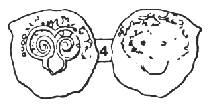
4. Ryazan (Ar Denga) Countermarked Mongol Dirhem, (Early 15th Century)
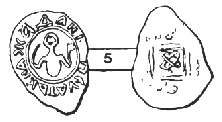
5. Suzdal (Ar Denga) Daniel Borisovich (1412-1451)
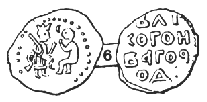
6.
Novgorod (Ar Denga) (Independent Period)
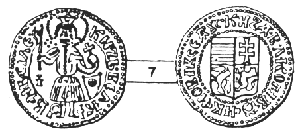
7. Moscow (Au Ducat) Ivan III
(1462-1505)

8. Moscow (Ae Pulo) (15th Century)

9. Moscow (Ae Pulo)
(15th Century)

10. Moscow (Ar Denga) Ivan III "Master Alexandro"

11.
Moscow (Ar Denga) Ivan III "Ornistoteles"


12-13. Moscow (Ar Denga)
Dimitri Donskoi (to 1389)

14. Moscow (Ar Denga) Dimitri Donskoi (to 1389)
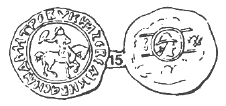

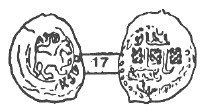
15-17. Moscow (Ar Denga) Vasili I (Dimitrievich) (1389-1425)




18-21. Moscow (Ar Denga) Vasili II (The Blind) (1425-1462)

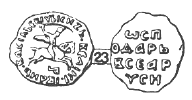

22-24. Moscow
(Ar Denga) Ivan III (The Great) (1462-1505)

25. Moscow (Ar Denga) Ivan
III (1462-1505)

26. Ivan III (Denga of Moscow)

27. Moscow (Ar Denga)
Anonymous - Ivan III and Vasili III
return to Perspectives in Numismatics